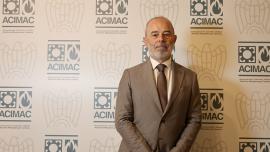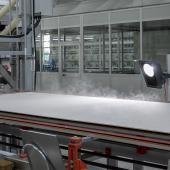Italian ceramic machinery sector sees 23% decline in sales in 2024
Final end-of-year figures confirm earlier forecasts: Italian manufacturers close 2024 with revenue of €1.82 billion after the previous year’s record high. Chairman Lamberti warns: “Unfortunately, the results were entirely expected. Tariffs and wars are already weighing on 2025.”
Luca Baraldi, MECS-Acimac ([email protected])
The final figures confirm the forecasts made last December. After two years of strong growth (+39% in 2021 and +14% in 2022) and record turnover of €2.37 billion in 2023, the Italian ceramic machinery manufacturing sector experienced a sharp downturn in 2024, losing nearly a quarter of its sales revenue (-23%) compared to the previous year. The sector’s total turnover fell to €1.82 billion, only slightly above 2019 levels.
These findings emerged from the 33rd National Statistical Survey conducted by the Mecs-Acimac Research Centre and were presented at the Acimac Annual Members’ Meeting held on 2 July in Sassuolo.
The slowdown already evident in 2023 (+0.9%) intensified in the following year, with negative trends across all key indicators.
Domestic sales fell by 17.6%, from €648 million to €534.3 million.
Export markets were hit even harder, experiencing a decline of 25%, with sales falling from €1,724 million in 2023 to €1,290 million in 2024, accounting for 70.7% of total turnover.
However, the structure of the companies in the sector saw only minor changes: 135 companies were active in 2024 (three fewer than in 2023) with a workforce of 7,152 people, a decrease of just 1.8% compared to the previous year.
International markets
Only two geographical regions recorded an increase in exports of Italian machinery in 2024. Africa experienced 5.2% growth, reaching €144 million and continuing the positive trend from the previous year (+51% compared to 2022). China also recovered partially from previous losses, growing by 13.7% to €51 million.
All other macro-regions saw declines, most significantly the European Union, the primary destination for Italian machinery exports. Sales to EU markets fell by 13.4% to €335.6 million, continuing the negative trend observed in 2023 (-27.6% compared to 2022).
Following 14% growth in 2023, exports to Asia (excluding China) dropped by 37.7% in 2024 to €184.4 million. Similarly, sales in the Middle East fell by 22.8% to €183 million, reversing the 7% growth seen in 2023.
Sales in the Americas also declined significantly. Exports to South America fell by 41.7% to €176 million after a strong performance in 2023, while North American sales declined by 42% to €104 million.
Finally, non-EU European markets registered a 21.4% decrease, with revenues dropping to €110 million.
Client sectors
In 2024, all six client sectors for ceramic machinery – ceramic tiles, sanitaryware, bricks and roof tiles, tableware, refractories and technical ceramics – suffered declining sales.
The tile machinery sector, which continued to dominate the market with an 83.5% share, recorded the largest drop in absolute terms, falling from €2 billion in 2023 to €1.52 billion in 2024 (-23.9%). The Italian domestic market declined by 17.2% to €475 million, while exports fell by 26.5% to €1,048 million.
Sales in the brick and roof tile sector declined by 24.6% to €101.4 million, with equal percentage drops in both the domestic market (€18.5 million) and exports (€82.9 million).
The sanitaryware machinery segment generated the same total revenues (€101.4 million, -14.1%), decreasing by 10.8% domestically to €23.5 million and by 15% internationally to €77.9 million.
Machinery sales to the refractories sector experienced the smallest decline (-4%), reaching €81.4 million, with stable export markets (+0.5%) only partially offsetting the 20% fall in domestic sales.
Lastly, tableware machinery sales totalled €12.4 million (-54.6%), while the technical ceramics sector recorded sales of €5.2 million (-36.4%).
Types of machinery
The shares of turnover by machinery type remained largely unchanged with respect to 2023.
Forming machinery climbed to the top of the revenue rankings at €332.3 million (-18.5%), followed by raw material preparation equipment (€246.5 million; -41%) and finishing machinery and tools (€245.4 million; -9.8%). Next came kilns (€195 million; -21%), digital decoration machines (€187.7 million; -1%), handling and storage equipment (€183.4 million; -28.5%), moulds, traditional glazing and decoration machines, sorting lines, packaging and palletising equipment and drying equipment.
It is also interesting to compare the types of machinery that are most popular in the domestic Italian market versus exports, with trends from 2023 continuing into 2024 in both cases. In Italy, finishing technologies generated the highest revenues (€105 million, -3.4%), followed by storage and handling technologies (€64.5 million, -28%). Internationally, forming technologies (€276 million) and clay preparation equipment (€189.5 million) were the top sellers.
Outlook for 2025
The Mecs-Acimac Research Centre’s survey also analysed sector companies’ expectations for the current year, which continues to be affected by the challenges faced in 2024.
Among companies surveyed, 26.5% anticipate a recovery in sales, while 40.3% expect stability and 33.3% foresee a further decline in business activity.
“Geopolitical tensions are also having a negative impact”
Commenting on the figures, Acimac Chairman Paolo Lamberti offered a number of insights:

“Last year our sector found itself squeezed between a cyclical downturn and a number of endogenous factors, such as unscrupulous international competition and rising production costs. If anything, the pressure has now intensified further as a result of US tariffs, the uncertainty caused by President Trump’s continued policy U-turns and fresh conflicts in the Middle East. The consequences of the war in Ukraine continue to be felt, with Russia still under trade sanctions, while stubbornly high energy prices are impacting customers’ operations not only in Italy and Europe but also across Asia.
We have little influence over geopolitics, so we must roll up our sleeves and leverage the strengths of Italian manufacturing in all markets and regions. With this in mind, we launched the “We Are Acimac” brand in 2024 to promote the quality, innovation and reliability of our technology.
“We will have to wait until 2026 to see a recovery in global investment, but in the meantime I’d like to note a number of positive aspects. First, digital decoration technology saw only a very modest decline in sales (-1%), while finishing machines and moulds achieved an above-average performance, despite the overall contraction.
“Amid the general slowdown, some export markets showed less negative and in some cases even positive performances. For example, sales volumes to Africa and China actually grew, while exports to the EU fell far less than the overall average.”
Did you find this article useful?
Join the CWW community to receive the most important news from the global ceramic industry every two weeks























